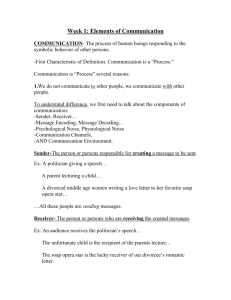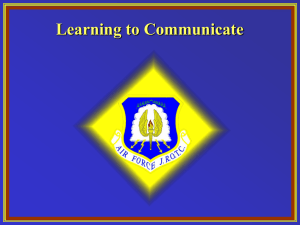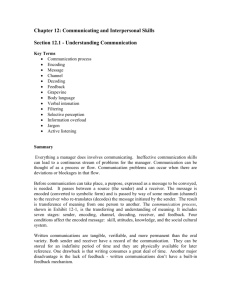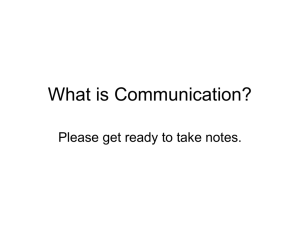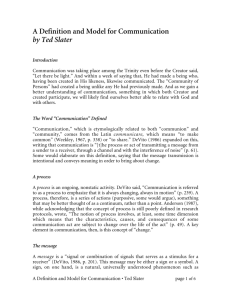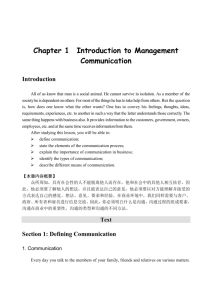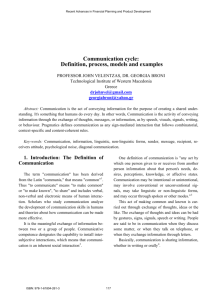Encoding- When a sender attempts to replicate his or her internal
advertisement
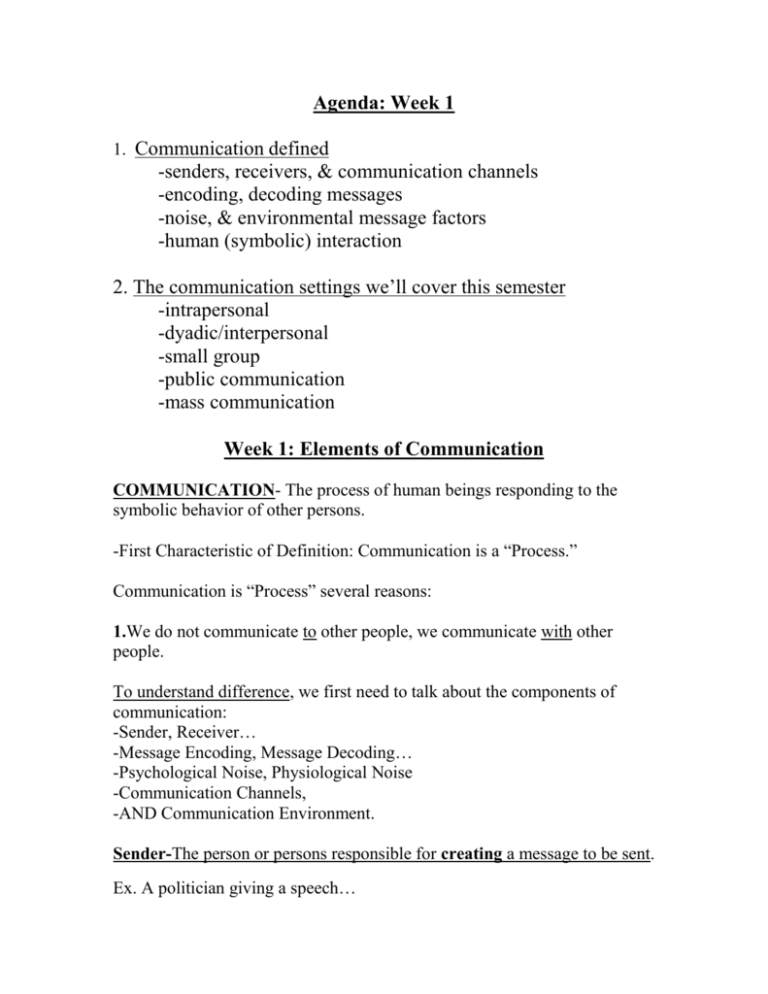
Agenda: Week 1 1. Communication defined -senders, receivers, & communication channels -encoding, decoding messages -noise, & environmental message factors -human (symbolic) interaction 2. The communication settings we’ll cover this semester -intrapersonal -dyadic/interpersonal -small group -public communication -mass communication Week 1: Elements of Communication COMMUNICATION- The process of human beings responding to the symbolic behavior of other persons. -First Characteristic of Definition: Communication is a “Process.” Communication is “Process” several reasons: 1.We do not communicate to other people, we communicate with other people. To understand difference, we first need to talk about the components of communication: -Sender, Receiver… -Message Encoding, Message Decoding… -Psychological Noise, Physiological Noise -Communication Channels, -AND Communication Environment. Sender-The person or persons responsible for creating a message to be sent. Ex. A politician giving a speech… A parent lecturing a child… A divorced middle age women writing a love letter to her favorite soap opera star… …All these people are sending messages. Receiver- The person or persons who are receiving the created messages. Ex. An audience receives the politician’s speech… The unfortunate child is the recipient of the parents lecture… The soap opera star is the lucky receiver of our divorcee’s romantic letter. Communication Channel- The medium a receiver uses to send his or her message. **Channels may be verbal or nonverbal** Ex. Speech is a channel… Writing is a channel… Non-verbal gestures are channels… Voice Tones are channels…And so on. Encoding- When a sender attempts to replicate his or her internal thoughts or feelings into some kind of external message medium for the sake of transmitting those thoughts or feelings to another person or persons. It’s easy to tell if sender encodes message poorly because he or she say things like: “That’s not what I meant to say,” or… “That’s not what I mean,” or… “What I really wanted to say was…” and so forth. If someone is a skilled “encoder,” we call him or her “articulate,” “well spoken,” or even “eloquent.” And research has shown that good speakers are considered more trustworthy, intelligent, competent, and personable than poor speakers… …even if speaker’s are saying exact same thing. Obviously, there isn’t always a relationship between speaking well & intelligence & competency… Sure some newscasters, actors, & politicians are bright…But many times they aren’t…but we think they are simply because they speak well. This phenomena -known as Halo Effect- refers to the fact that if people identify you as skilled in one area… …They often will assume you are skilled in other areas as well. We see this happen all time w/ celebrity’s & not so intelligent public. Ex. Dr. Phil’s Diet Plan. Dr. Phil’s a psychologist, not a dietician, but people illogically assume, since he’s doctor …since he’s confident & successful…he must also know something about dieting. One good thing about courses in Human Communication Studies often contain public speaking component, in addition to writing component. English, History, Sociology, Psychology…only writing, no speaking. But remember what text said about what employers are looking for: “Over 90 percent of the personnel officials at five hundred U.S. Businesses stated that oral communication skills play a bigger role in career achievement than technical competence, experience, or academic background. Of course, technical skill, experience, education important, but if you can’t communicate your knowledge, ideas, arguments to others… Technical skill & experience aren’t worth much. Many college courses teach written encoding skills…But this course focuses primarily on oral encoding skills… …Which are at least equally if not more important than writing skills. And I’m not just talking about public speaking. I’m talking about bettering your encoding skills in personal settings, romantic settings, intercultural settings, business settings, group settings… …So public speaking is very small portion of this class… **So talked about Sender, Receiver, Communication Channels, & Encoding… Message Decoding- Occurs when the receiver attempts to ascertain the meaning of the sender’s message. And figuring out what other people “mean” isn’t easy. I’m sure all of us had times when we’ve had others become frustrated w/ us because we didn’t understand what they meant… I’m sure we’ve all became frustrated w/ other people when they didn’t understand what we meant. **Communicologists call anything prevents effective decoding “Noise” Noise- Any force that interferes with effective communication. Three types: External noise, physiological noise, psychological noise. External Noise- Refers to any physical phenomenon that might impair a receiver’s ability to decode a message. Physiological Noise- Involves biological factors in the receiver or sender that interfere with accurate reception. Ex. Seinfeld: George’s “I love You” Psychological Noise- Involves mental forces within a receiver or sender that might inhibit his or her ability to either encode or decode a message correctly. Ex. If a receiver suffers from low-self esteem, might interpret a sincere compliment as sarcastic or condescending even though it wasn’t. *There are also macro level factors that affect communication process Ex: Communication Environment- Fields of experience or cultural backgrounds that influence the way communicators encode and decode messages. We’ll be talking quite bit about how culture affects human interaction… …(And you’ll be reading about in your text as well: Chapter Six)… But our past experiences also affect how we interact w/ other people. Ex. Racist beliefs often caused by one bad past experience… …Child…negative situation…someone different ethnic background… …Flawed perceptions…contrastive information…false categorization… …Hard to let go of. So: Now we’ve defined components of communication – sender, receiver, channel, noise, environment…let’s get back to our definition of communication as “process” Essentially, defining communication as process means communication does not work linearly but circularly instead. Communication in Interpersonal situations involves sending and receiving messages at same time. Ex. While I’m lecturing, you’re giving me nonverbal feedback about your opinion of lecture: -Yawning, stretching, sleeping, nodding off, doodling in notebook, etc. We’re both sending and receiving messages at same time! Sometimes we consciously plan our communication…sometimes we don’t. Misunderstandings occur when we assume all communication is planned. Ex. If one of you yawns or nods off, you might be intentionally acting rudely… …Or maybe you’re trying to be good listener, but are tired because you were up all night studying for another test. If I jump to conclusion about reason for your yawning, I may end up unjustly punishing you in participation points department. *Sometimes our own unconscious communication has negative consequences for ourselves & person we’re communicating with. Ex. If your supervisor is instructing you and you fold your arms… …He or she may interpret the arm folding as an act of defiance and become more stern in future when interacting with you… …So you weren’t trying to be defiant, but your unconscious communication gave impression that you were. The important lesson here is that most people assume messages are easily created and easily interpreted…but this is just not the case. …We have to remember that many factors are continually influencing our ability and intent when we’re encoding and decoding messages. Miscommunication, resentment, anger and hostility often result in relationships when communicators unaware of influence factors have. Bottom line: If you remember that communication is process… …You’ll communicate more effectively because you’ll be aware of many factors involved in any given communication event: You’ll be less likely to assume, less likely to rush judgment… …More likely tailor your message to your audience correctly, More likely to correctly encode and decode other’s messages. Second aspect of our definition is that this class deals with HUMAN COMMUNICATION only. Third, COMMUNICATION is “Symbolic.” Symbols- Are things used to stand for or represent something else. Symbols not limited to words; symbols include nonverbal displays or objects. Ex. “Red light” symbolizes an order to “Stop.” Colors “red, white, and blue” symbolize patriotism. Wearing “Oakland Raiders Gear” symbolizes you can’t read and probably abuse drugs… *So symbols are anything that stands for another thing. Also, symbols are arbitrarily developed objects. They have meaning only because certain people agree that they mean the same thing. Obviously, across cultures, symbols are rarely the same. Ex. United States traffic signs for “Yield,” “Merging Lanes,” “Pedestrian Crossing” may or not be the same in other countries And even people in same culture attribute different meaning to same symbols. Ex. (ask two people) If someone or something is Old Fashioned, …what does that mean? Can mean: “Traditional,” “Victorian,” “Time-honored,” “Quaint.” Can mean: “Obsolete,” “Archaic,” “Out-of-Date.” And as book points out, symbolic non-verbal activity can have different meanings for different people: Ex. Frown = Anger or Unhappiness? Hug = Friendly greeting or Expression Romantic Interest Is someone who pats you on back being supportive or patronizing? If we assume that our interpretation of symbols is universal, misunderstandings often result. TYPES OF COMMUNICATION Intrapersonal Communication- Involves communicating with yourself. Psychology deals with Intrapersonal Communication much more than Human Communication Studies does. Most Human Communication Studies Professors don’t consider “Intrapersonal Communication” to be communication at all because two or more people are not involved. Which brings us to… Dyadic/Interpersonal Communication- If you’ve skimmed book or paid attention to today’s lecture, obvious that interpersonal communication is focus of the class. Ex. That’s why focus is on “perception,” “listening,” “language choice,” etc. Dyadic Communication involves two people, and is most common type of communication Small Group Communication- A group is too large to be considered a “small group” when each member cannot actively communicate with the other group members. Good measuring stick if group is small or not is this: If group were seated around a large table, and people would have to yell to speak with other members, no longer small group. Groups posses interesting characteristics “Dyads” do not. 1. Group members can form coalitions to defend positions against other group members. In Dyad, disagreement, on your own; no one to team up with. Implication- The more people that team up against a group member, more likely he or she will give in. AKA “Peer Pressure.” SIDE NOTE: There are three strategies you can use if you’re in minority to get your way: 1. Convince the group that you’re disagreeing not to be stubborn, but because you have expertise and experience in the area of disagreement. Ex. If you’re involved in campus politics at CSUF and you’re campaign team disagrees with you about some campaign strategy… …You might casually say: “Well, this plan got me elected as High School President, and the Journal of Applied Political Science recommends it as campaign strategy for college politics as well.” 2. If don’t have expertise or experience, try these strategies: First, agree wholeheartedly with group on most issues, even if you really don’t, and then disagree adamantly on issue that matters to you most. Because you agreed w/ group on other issues, they’ll think you’re on “their side,” and seriously consider your arguments when you do disagree. Second, disagree competently with EVERYTHING the group says. This may make you appear confident (“maybe he knows something we don’t”), and cause a person or two to jump to your side… …Research has shown that once one person changes sides, more may follow. This is known as “Mutiny” in political terms, right? This is why dictators so concerned with anyone who disagrees with them. I should also point out that people in groups have been known to take risks they wouldn’t when alone or in a dyad. Why? Social Proof + Deindividuation. Social Proof- The “Everybody’s Doing It” rationale. Humans model their behavior after other human beings. This is why 99% of Girls in Southern California have tattoos on their lower backs. Monkey see, Monkey do. Another Example of Social Proof: Ford has identified and recruited certain high profile “Soccer Moms” to drive their mini-vans for free. Other mom’s see these “perfect mothers” driving Ford Windstars & want to buy them. Deindividuation- “Getting lost in the crowd.” Because being in a large crowd makes people both AROUSED and ANONYMOUS, they often do things they wouldn’t normally do. Ex. Riot. First, people in riot are aroused. They’re drunk, reacting to some event like their team’s championship or court verdict. Second, people are anonymous… They feel like they can’t be caught because there are so many people involved. Third difference between groups & dyads is that while dyads can have “leader,” groups ALWAYS have leader, and obviously character of leader shapes character of group. Public Communication: Occurs when a group becomes too large for all members to contribute. Characteristics: 1. Unequal amount of speaking (one or two speakers usually dominate) 2. Limited Verbal Feedback from audience. Audience isn’t supposed to interrupt. Ex. Classroom Lecture, Church Homily, Presidential Speech Mass Communication: Characterized by messages that do not allow for ANY immediate audience feedback, verbal or nonverbal. Ex. Movies, TV Shows, Magazines, Newspapers, Radio Broadcasts. Mass Communication or “Mediated Communication” differs from other forms of communication in several ways: 1. Messages are aimed at and carefully tailored to specific demographic audiences. 2. There is no contact between receiver & sender, so sender has total control over message sent. 3. But, sender also has no way clarifying miscommunications as in other communication settings. 4. Mass comm. is generally sponsored by large organizations. For these reasons and others, Mass Communication very different from group and interpersonal communication. Concepts we deal with for most of book deal with latter two issues; last chapter we cover will deal w/ mass comm.
